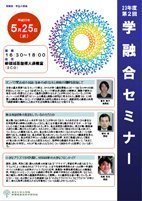AY2011 2nd Gakuyugo Seminar
- Date&Time:
- May 25, 2011 16:30~18:00
- Venue:
- Large Lecture Room (2C0), New Frontier Science Bldg.

The Story of Protein Synthesis: Toward a Better Understanding of the Origin of Life and Disease
Associate Professor Nono Tomida
Proteins, the basic building blocks of life, are synthesized on the ribosome using mRNA, a copy of the genetic information in DNA, as a blueprint. The regulation of protein synthesis (translation) plays an important role in development, differentiation, and disease of cells and individuals. The 2009 Nobel Prize in Chemistry was awarded for the study of the structure and function of the ribosome. In this lecture, we will focus on the current status of research on the mitochondrial translation system, which is highly relevant to human diseases, and introduce the latest findings in translation research and the current status of development of small molecule compounds targeting translation regulation.

Why do fish have a 'fish shape'?
Professor Hiroshi Kagemoto
Fish are known to be remarkably efficient swimmers, and their swimming has long been a subject of interest to prominent applied mathematicians. While there are many different species of fish, most of them share a common characteristic: they are streamlined. This is the fact that they are "fish-shaped," consisting of a streamlined body and a thin, deep caudal fin, joined by a hinge-like neck. Another characteristic of the fish is that it swims by twisting its body sideways. In this lecture, I will address the speaker's own question as to why fish have a "fish shape". Based on the assumption that the current "fish shape" is the result of millions of years of evolution, I will use mathematical optimization methods to identify the "optimal shape for swimming" and examine whether it is the "fish shape In this paper, I will describe the results of my investigation into whether the "optimal shape for swimming" can be the "fish shape.

A small plasma opens up a big frontier in materials science.
Professor Kazuo Terashima
Plasma" is the fourth state of matter after solids, liquids, and gases. Named by Langmuir, the founder of interfacial chemistry, "plasma" has been developed as a fundamental science and technology in a wide range of fields of science and technology, including material device process applications such as semiconductor device fabrication, environmental applications such as waste and hazardous material treatment, mechanical engineering applications such as space rocket engines, and medical applications such as diagnosis and surgery. The importance of "plasmas" has been increasing as a fundamental science and technology in a wide range of scientific fields, including material device process applications such as semiconductor device fabrication, environmental applications such as waste and hazardous material treatment, mechanical engineering applications such as space rocket engines, and medical applications such as diagnosis and surgery. In this seminar, I will talk about the great potential of new science and technology opened up by "small plasmas (microplasmas)", a new field in this field.
*The contents of this page were developed based on a machine translation.

